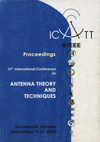Influence of the microwave radiation of different polarization state on transinactivation effect and viability of Drosophila
DOI:
https://doi.org/10.1109/ICATT.2003.1238879Keywords:
microwaves, drosophila, reproductive ability, transvection, transinactivation, chromosomes, interphase nucleusAbstract
The influence of microwave radiation (λ = 3.8 mm, intensity P = 0.1 mW/cm2) on stocks and hybrids of Drosophila melanogaster was investigated. Irradiation at the egg stage negatively influences the reproductive ability and output of the imago, and induces significant changes in the eye pigmentation of the imago. The effect of radiation depends on the state of polarization of the radiation. Linearly polarized radiation and left circularly polarized radiation induce a decrease of pigmentation, right circularly polarized radiation induces an increase of it. As the amount of the pigment is connected with manifestation of the transinactivation effect and the reinforcement of the transinactivation effect is connected with an increase of the conjugation of homologous chromosomes, the authors draw the conclusion that left polarized radiation and linearly polarized radiation cause the reinforcement of the transinactivation effect. The authors suppose that the observed effect is connected with an increase of chromosome conjugation in the interphase nucleus; the action of the right circularly polarized radiation is connected with a reduction of the effect of transinactivation that, in its turn, is connected with a reduction of the conjugation of homologous chromosomes in the interphase nucleus.References
Henikoff, S. Nuclear organization and gene expression: homologous pairing and long-range interactions. Curr Opin Cell Biol., 1997, Vol. 9, p. 388.
Henikoff, S.; Jackson, J.M.; Talbert, P.B. Distance and pairing effects on the brown Dominant heterochromatic element in Drosophila. Genetics, 1995, Vol. 140, p. 1007.
Michaelson, S.M. Microwave biological effects. An overview. Proc. IEEE, 1980, Vol. 68, No. 1, p. 40.
Shakhbazov, V.G. Eukaryotic gene activity in some connection with homologous chromosomes interaction and bioelectric properties of the cell nucleus. Genetics, 1973, Vol. 74, p. 249.
Published
2003-09-28
Issue
Section
Industrial and medical applications of microwave technologies

